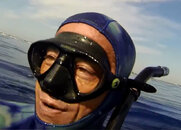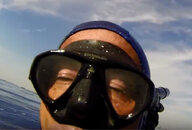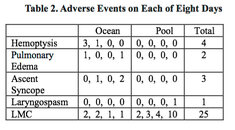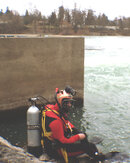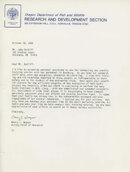DD,
You stated,
..Also, as for the definition of shallow water black out. It has a very specific meaning in the freedive community. Application of this term to swimmers in a pool is not consistent with the common usage. That was my original point.
If the pool safety Nazi's want to hijack the term for their own use...and dilute the meaning of the word.. well not much we can do to stop them i guess...
I would like to point out that the use of the term "Nazi" and modifying it with "safety" is an oxymoron. It also shows a weak argument, as the concern about SWB was first associated with underwater swimming in pools in published studies:
Hyperventilation before an endurance underwater swim can cause underwater syncope and subsequent drowning. Underwater swimmers hyperventilate to increase arterial oxygen content in an attempt to delay the time when the desire to breathe becomes overwhelming. However, the increase in arterial oxygen content is negligible, while the reduced carbon dioxide results in reduced cerebral blood flow, reduced oxygen dissociation from hemoglobin and lack of stimulus for breathing. Fifteen deep breaths may set the stage for an underwater blackout."
Underwater Blackout--A Mechanism of Drowning, Dumitru and Hamilton,
GP, April 1964
http://www.safetylit.org/citations/index.php?fuseaction=citations.viewdetails&citationIds[]=citjournalarticle_13813_11
In 1973 I was on a search mission with the 304th Aerospace Rescue and Recovery Squadron (Reserve) in the Columbia Gorge, looking for a light airplane. We searched broken trees (wind damage, it turned out), then the pilot decided to head to the north side of the Columbia River. As we were mid-way across the river, the helicopter's engine (an old, HH-34 recip engine helicopter we got from the Navy), quit. We were headed down, and the pilot notified us in the crew compartment to prepare for an autorotation and landing or ditching in the water. I heard the message on the headphone, sat down and buckled up. The other PJ did not sit down; he was in the doorway, looking out. I got up and poked him, saying that he needed to sit down and buckle up. He was new, and I out-ranked him, but he continued to ignore me. So I physically picked him up, shoved him into the seat, and forced him to get his seat belt on, then I sat down and belted in again too. I was very happy to see the shoreline go under our chopper, and we settled into a cattle field on the north side of the river for a perfect autorotation landing. The pilot came out and said, "Look at these hands, look at these hands!" His hands were shaking almost uncontrollably from the adrenaline. The other PJ, when I asked him why he didn't buckle up, he said he was watching another logging company helicopter with a full load of logs, and it was climbing really fast...he couldn't understand why it was climbing so fast with that load. It wasn't climbing; we were falling out of the sky!
I felt somewhat the same way with you a few posts back, when you continue to ignore the science behind the two mechanisms for shallow water blackout (which Wiki now splits into Shallow Water Blackout and Deep Water Blackout). I feel like putting my Staff Sergeant stripes back on, and yelling at you to "Shut up, sit down and listen!" Respecting your elders in the diving community wouldn't hurt either. So here goes again:
--All blackouts are potentially life-threatening.
--Without immediate in-water help, SWB can and has killed divers and swimmers.
--Hyperventilation will induce a low blood CO2, hypocapnea, which will postpone the "must-breath" signal to the brain.
--Even if not hyperventilating, a deep diver can blackout near the surface due to the decreased pressure resulting in a loss of oxygen to the brain when that oxygen goes back into the lungs (reverse osmosis).
--All blackouts are potentially preventable. This has to do with technique, and knowing limitations of breath-hold diving.
In the 1987 paper I linked above, there are two descriptions of blackout, "Breath-hold Blackout" and "Ascent Blackout." These are detailed below:
BREATH-HOLD BLACKOUT.
BH blackout (BB) is most commonly recognized in mishaps that occur in swimming pools and other relatively shallow water. Often, the swimmer or diver made no attempt at all to reach the surface. The same sequence can presumably occur at any depth, but few cases other than those observed from the surface would be recognized and attributed to BB. Al Craig (2) deserves gratitude for describing BB and bringing it to the attention of physicians and the aquatic public.
I like Hermann Rahn's way of depicting the physiological basis of BB. Fig 1 was borrowed from him. It is based on an
02-C02 diagram. The "C02 reservoir" on the right includes a small column representing the lung. The blood-and-tissue reservoir is much larger; but it can be depleted by hyperventilation, and the input from CO2 production during a BH may not bring it back even to a normal level. As the lower arrow on the graph suggests, subsequent gas exchange may carry the P02 well into the hypoxic zone before the combined effect of falling P02 and PC02 would produce significant air hunger...
...ASCENT BLACKOUT.
Ascent blackout CAB) is an insidious hazard. A diver who starts ascent in good condition and at a seemingly appropriate time may lose consciousness and drown before he can resume breathing. The basic difference between AB and typical BB is a factor that I call IIborrowed II Increased pressure at depth permits a diver to consume more oxygen from his alveolar gas than would be available at pressure. The mortgage comes due when he ascends. As ambient pressure drops, the P02 of-expanding alveolar gas drops in proportion, and the final alveolar and arterial P02 consciousness. If the alveolar P02 falls below the mixed venous oxygen tension in the process, the lung will extract oxygen from the blood. In their recent computer modeling of breath-hold dives, Olszowka and Rahn (5) have refined our understanding of this process especially for deeper dives, but I will use a more common sort of example...
Thinking this dialog through, I think that there is a difference between the freediving community and the scientific community on a lot of this discussion of SWB. I also think that some of what the freediving community thinks is based as much upon mythology as on science. Let's think about that, and see whether we can come to some sort of agreement. I have some other references, but this is already way too long.
SeaRat




